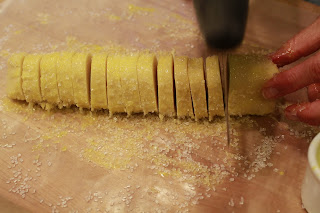This is the final post in a short series on cookies. We began with a recipe for Strassburgers, followed by a recipe for Cantucci di Pinoli e Rosmarino. Now we conclude with Dorie Greenspan’s recipe for an outstanding French cookie called a sablé. The recipe appeared in a 7 November 2004 New York Times article entitled “Cookie Master”.
Wonderfully rich, Greenspan’s sablés are crisp yet tender with a distinctly crumbly texture (sablé means sandy in French). Where most sablé recipes call for just a pinch of salt, Greenspan, influenced by the great pastry chef Pierre Hermé, adds considerably more. Her take on the sablé is the only cookie that begins to rival my dear old aunt’s Armenian butter cookie called kurabia.
Here is Greenspan’s recipe for sablés.
- 2 sticks (8 ounces) unsalted butter (preferably high-fat, like Plugrá), softened at room temperature
- ½ cup granulated sugar
- ¼ cup confectioners’ sugar, sifted before measuring
- ½ teaspoon salt, preferably sea salt
- 2 large egg yolks, preferably at room temperature
- 2 cups all-purpose flour
For the decoration (optional):
- 1 egg yolk
- Crystal or dazzle sugar
1. Working in a mixer fitted with the paddle attachment, beat the butter at medium speed until it is smooth and very creamy. Add the sugars and salt and continue to beat until smooth and velvety, not fluffy and airy, about 1 minute. Reduce the mixer speed to low and beat in 2 egg yolks, again beating until well blended.
2. Turn off the mixer, pour in the flour, drape a kitchen towel over the mixer and pulse the mixer about 5 times at low speed for 1 or 2 seconds each time. Take a peek; if there is still a lot of flour on the surface of the dough, pulse a couple of more times; if not, remove the towel. Continuing at low speed, stir for about 30 seconds more, just until the flour disappears into the dough and the dough looks uniformly moist. If you still have some flour on the bottom of the bowl, stop mixing and use a rubber spatula to work the rest of it into the dough. (The dough will not come together in a ball—and it shouldn't. You want to work the dough as little as possible. What you're aiming for is a soft, moist, clumpy dough. When pinched, it should feel a little like Play-Doh.)
3. Scrape the dough onto a work surface, gather it into a ball and divide it in half. Shape each piece into a smooth log about 9 inches long (it's easiest to work on a piece of plastic wrap and use the plastic to help form the log). Wrap the logs well and chill them for at least 2 hours. The dough may be kept in the refrigerator for up to 3 days or frozen for up to 2 months.
4. When ready to bake, center a rack in the oven and preheat the oven to 350°F. Line a baking sheet with a silicone baking mat or parchment paper and keep it at the ready.
5. To decorate the edges of the sablés, whisk the egg yolk until smooth. Place one log of chilled dough on a piece of waxed paper and brush it with yolk (the glue), and then sprinkle the entire surface of the log with sugar. Trim the ends of the roll if they are ragged and slice the log into 1/3-inch-thick cookies.
6. Place the rounds on the baking sheet, leaving an inch of space between each cookie, and bake for 17 to 20 minutes, rotating the baking sheet at the halfway point. When properly baked, the cookies will be light brown on the bottom, lightly golden around the edges and pale on top. Let the cookies rest 1 or 2 minutes before carefully lifting them onto a cooling rack with a wide metal spatula. Repeat with the remaining log of dough. (Make sure the sheet is cool before baking each batch.) Makes about 50 cookies.
Merry Christmas and A Happy New Year to All!


















